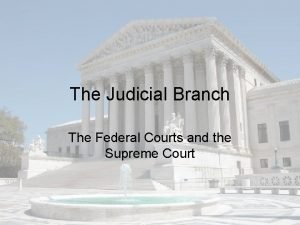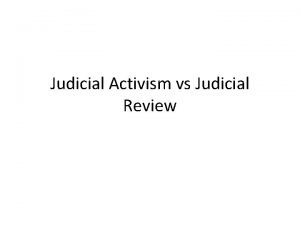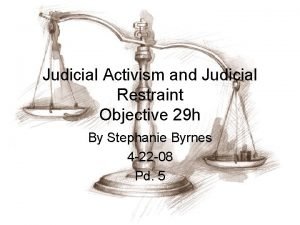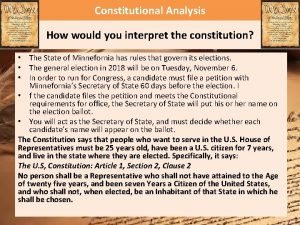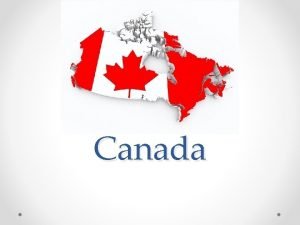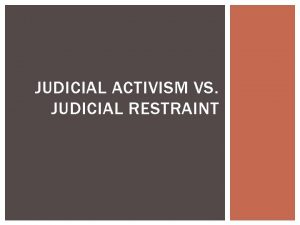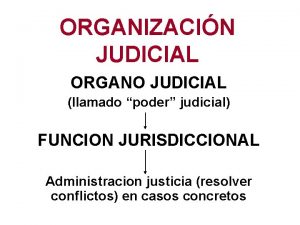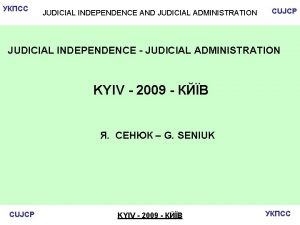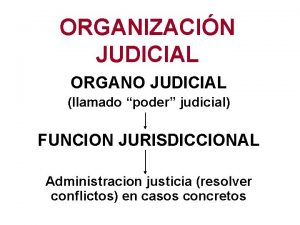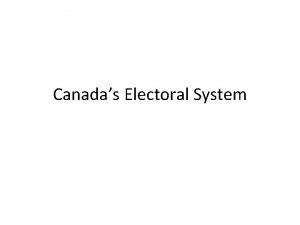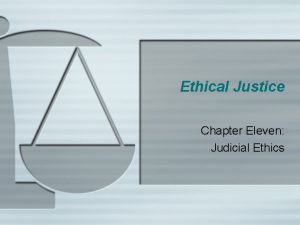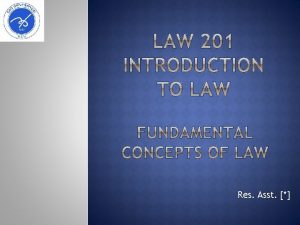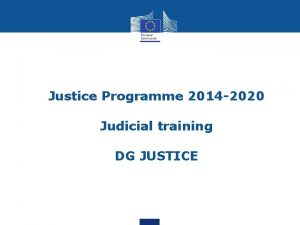CANADAS JUSTICE SYSTEM GOALS OF THE JUDICIAL SYSTEM














- Slides: 14

CANADA’S JUSTICE SYSTEM

GOALS OF THE JUDICIAL SYSTEM: 1. Ensure society operates in a peaceful and orderly manner 2. Balance the need for social order with respect for the individuals rights of the citizen

FUNDAMENTAL LEGAL RIGHTS OF CANADIANS The right to be free from unreasonable search or seizures The right on arrest to be told of the reasons The right to be represented by counsel (lawyer) The right, on being charged with an offence, to be told the details of the offence The right to a trial within a reasonable time The right to be presumed innocent until proven guilty The right to not be denied bail (temporary release) without just cause

THE CRIMINAL JUSTICE PROCESS 1. 2. 3. 4. The Criminal Investigation The Courts The Trial Verdict and Sentencing

THE CRIMINAL INVESTIGATION Acting on information (ie. From witnesses), the police obtain warrants – legal documents – for arrest and/or search The suspect is told the charge, told he can consult a lawyer, and is brought before a judge The judge decides whethere is enough evidence to proceed with trial and whether bail can be granted

THE COURTS There are federal and provincial courts which each have different jurisdictions (ie. Federal – immigration) Within federal and provincial, you can appeal your case “higher” – Court of Appeal or the Supreme Court hears only a very FEW cases – the ones of national importance, that might cause a change in law or in how law is interpreted

SUPREME COURT JUSTICES

THE TRIAL Adversarial system – determining guilt is done in a clash/fight between the prosecution (Crown) and the defence § Two opponents argue their case to the best of their ability Burden of proof rests upon the prosecution – they must show the suspect is guilty beyond a reasonable doubt Trial can be before a judge OR a jury of 12 citizens selected by the prosecution and the defence from a large group who received notices to appear at the court Quality of evidence: § Hearsay is not permitted – things that witnesses have heard others say, not what they have personally observed § Judge can also rule evidence inadmissible (ie. If obtained by a violation of right) § The suspect (defendant) is not required to testify

VERDICT AND SENTENCING After the final arguments from the prosecution and the defence, the judge makes the “charge to the jury” – it’s a review of the facts and an explanation of the law that applies to the case Once the jury had decided, the judge allows the defendant to leave if found innocent or sentences him if found guilty

PRINCIPLES OF SENTENCING Punishment – so that the public understands the offence was serious Deterrence – discourage the offender and others from repeating the crime Protection – of the public from dangerous people Rehabilitation – of the offender so that he or she can rejoin society as a law-abiding, productive citizen

SENTENCING OPTIONS Prison time Probation (have to stay out of trouble, follow up with probation officer etc) Conditional sentence (no penalty if the offender meets certain requirements ie. Fines, community service, etc) Fine Restitution (repayment to victim) Community service Open custody in a group home (for youth)

YOUTH CRIMINAL JUSTICE ACT Youth between ages 12 and 17 are called young offenders Youth must be held accountable for criminal activity, but not to the same extent as adults Youth have all the same legal rights as other as well the right: § To have a parent/guardian present during questioning In court – judge often conducts a trial alone Youth’s names are usually not made public Sentences are often lighter, with an emphasis on rehabilitation, but a judge can impose a stiffer, “adult sentence”

WRONGFUL CONVICTIONS Sometimes Canadians are convicted of crimes they did not commit and spend years in jail for them Some have later been exonerated (found innocent) due to DNA evidence Famous examples: David Milgaard (20 years in prison) and Romeo Phillion (31 years in prison) Organizations such as the Innocence Project work freeing people they believe to be innocent § Three factors they say lead to wrongful convictions: § Tragic event § Suspect who lacks power or authority § Suspicious evidence

CIVIL LAW Criminal law is a public offence against society Civil law is private disputes between individuals (ie. Sueing over property ownership, contracts, etc) When you decide to sue, you are the plaintiff, and you file a plea with the court outlining your complaint and the remedy The defendant responds with a statement of defence The issue can be resolved out of court or be brought to trial before a judge or 6 jurors Results: Defendant can be ordered to pay damages (ie. Car accident), issue a declaratory order that states the rights of the parties (ie. Terms of a will), or issue an injunction which requires someone to stop doing something (ie. Make noise)
 Strategic goals tactical goals operational goals
Strategic goals tactical goals operational goals Strategic goals tactical goals operational goals
Strategic goals tactical goals operational goals Judicial activism v. judicial restraint
Judicial activism v. judicial restraint Judicial restraint vs judicial activism
Judicial restraint vs judicial activism Judicial activism vs judicial restraint
Judicial activism vs judicial restraint Judicial restraint vs judicial activism
Judicial restraint vs judicial activism Judicial activism vs restraint
Judicial activism vs restraint What is canada's economic system
What is canada's economic system Temperatura en las cañadas del teide
Temperatura en las cañadas del teide Canadas landforms
Canadas landforms Canadas physical geography
Canadas physical geography Whats canadas longest river
Whats canadas longest river Canadas 5 regions
Canadas 5 regions Canadas head of state
Canadas head of state Iespm granada
Iespm granada


